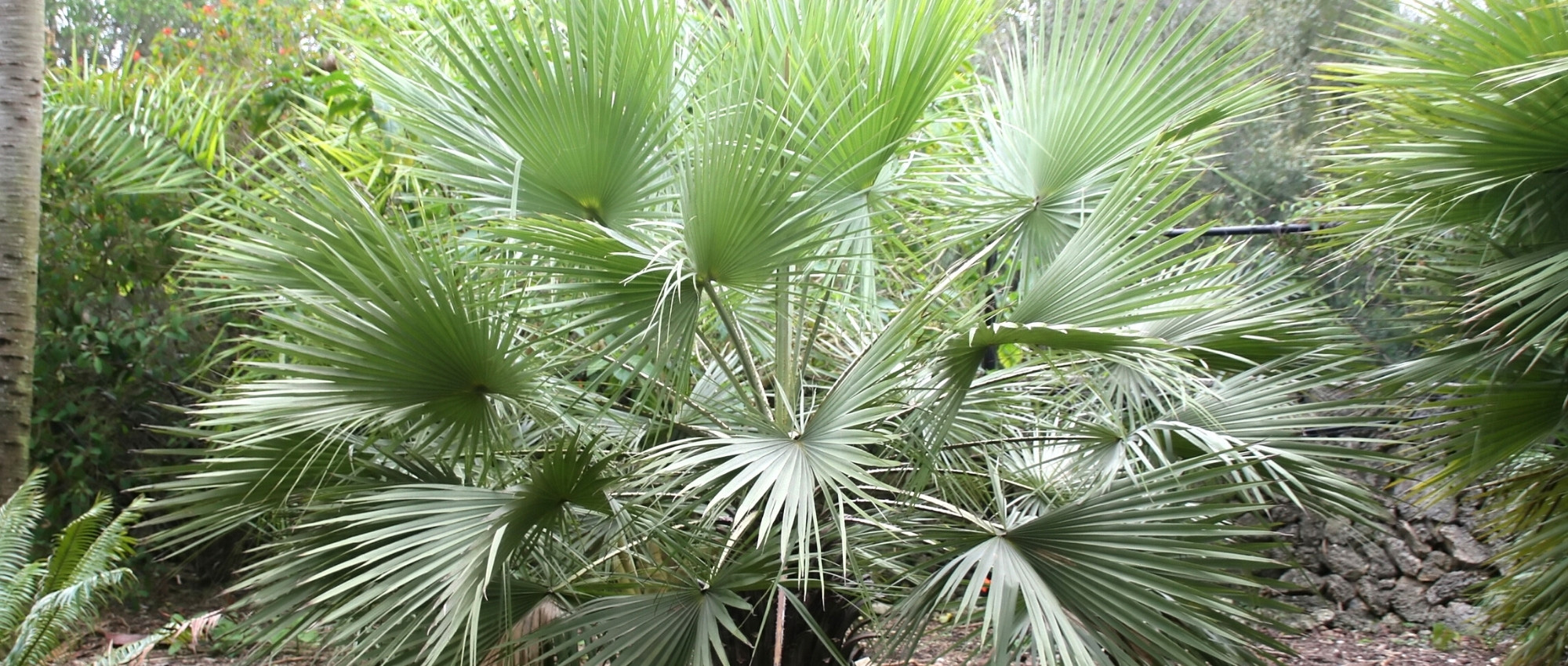
Brahea: planting, growing and care
Contents
Brahea in a nutshell
- Brahea are beautiful palms with fan-shaped leaves
- Brahea armata has a stunning silvery hue, slightly bluish
- They are perfect for creating an exotic atmosphere
- They are among the most beautiful hardy palms, tolerating temperatures down to -10 / -12 °C
- Older specimens provide a lovely summer flowering
A word from our expert
Brahea are beautiful palms native to Central America, featuring fan-shaped leaves and showing considerable cold hardiness (depending on the varieties, down to -12 °C in well-drained soil). The most well-known is the Mexican Blue Palm, Brahea armata, valued for its palmate leaves of a stunning silvery-blue colour, giving it a very unique metallic appearance! It is undoubtedly one of the most beautiful hardy palms.
In addition to their magnificent foliage, their spectacular inflorescences are also appreciated, taking the form of large cream-yellow panicles. However, they only appear on specimens at least 30 years old: younger Brahea do not flower, so patience is essential to enjoy them!
Brahea requires a sunny location, poor and perfectly drained soil, preferably rocky or sandy. It has the advantage of being very drought-resistant during summer! It is perfect for bringing an exotic atmosphere to a dry garden, such as a Mediterranean style, alongside lavenders, santolines, cistus, Jerusalem sages, and succulents.
Discover the most beautiful varieties of Brahea and all our tips for successfully cultivating them in the ground or in pots!
Botany
“`html
Botanical data
- Latin name Brahea sp.
- Family Arecaceae
- Common name Brahea, Mexican Blue Palm
- Flowering in July-August, on specimens at least 30 years old
- Height up to 15 m
- Sun exposure full sun
- Soil type rather poor and draining, neutral or calcareous
- Hardiness down to -10 °C
Brahea comprises 11 species of palms native to Mexico and Central America (Nicaragua, Honduras, Guatemala…), extending to southern California. They thrive in arid or semi-desert regions, making them well-suited to drought and rather poor, ungrateful soils. In the wild, they are found particularly in gorges and canyons, as well as on wooded slopes. They are valued in gardens for their relative hardiness. The Brahea armata and Brahea edulis, for example, can withstand temperatures between -10 and -12 °C.
Brahea belongs to the large family of palms, the Arecaceae. This palm was once named Erythea, before changing its scientific genus to Brahea. It was named in honour of the astronomer Tycho Brahe (1546-1601). The species name of Brahea armata comes from the Latin armatus: “armed”, due to the thorns present on the petiole.
Like other palms, Brahea does not form a trunk but a stipe. The stipe of Brahea is thick, stout, and upright, brown in colour, and unbranched. It can reach up to 45 cm in diameter.
Brahea grows to between 6 and 12 m tall, with the tallest specimens reaching up to 15 m. However, these palms grow slowly (notably Brahea armata), and they maintain a more modest size when grown in pots rather than in the ground.
At the top of the stipe, Brahea forms a crown of large leaves, measuring between 1 and 2 metres in diameter. They are costapalmate, meaning they have a fan shape but with a central axis (the petiole extends into the centre of the lamina). They are divided into 40 to 60 fine, deeply cut segments, almost to the centre of the leaf. The tips of the segments are bifid, splitting into two. The leaves are rigid and leathery. They are borne on long petioles, about 1 m long. The petioles of Brahea armata are equipped with small pale yellow hooked spines.

The leaves of Brahea edulis, Brahea armata, and Brahea calcarea (photos: weta2000nz / Joe Blowe / Scott Zona). The central axis of the costapalmate leaves is discernible.
The Brahea armata is known for its blue-grey, almost silvery leaves. This is due to a whitish waxy coating on the leaves, which protects them from the scorching rays of the sun. The Brahea edulis, on the other hand, has more ordinary foliage, light green in colour.
The leaves of Brahea emerge from the centre of the crown, above the stipe, and then gradually droop. Old dried leaves remain attached to the stipe, forming a kind of grey skirt, similar to Washingtonia. This skirt helps protect the stipe from temperature fluctuations and pests.
The leaves eventually fall over time, as the palm grows, and the bases of their petioles leave ringed marks on the stipe.
The Brahea must be mature, aged 30 to 40 years, to begin flowering. When it does, its flowering is a true spectacle! In summer (July-August), it adorns itself with spectacular panicles measuring 4 to 6 m long! These appear in the axils of the leaves and gracefully droop towards the ground in an arching manner. They consist of a multitude of small cream-yellow bell-shaped flowers, 1 to 2 cm in diameter. These flowers have three petals and are bisexual: they contain both stamens and pistils. Thus, Brahea are hermaphroditic, both male and female. Therefore, a single plant is sufficient to produce fruits and seeds.
The Brahea produces spherical fruits (drupes), brown and shiny, about 2 cm in diameter. The fruits of the species Brahea armata and Brahea edulis are edible and contain sweet pulp! The fruits ripen in summer, during the following flowering. Each fruit contains a seed, which can be harvested and sown.

The flowering of Brahea armata, in the form of large panicles made up of tiny pale yellow flowers (photos cultivar413)
“`
The main varieties of Brahea
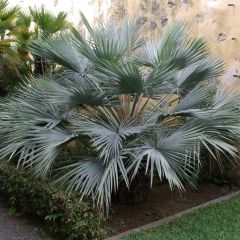
Brahea armata - Mexican blue palm
- Flowering time August, September
- Height at maturity 12 m
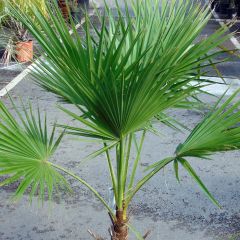
Brahea edulis - Guadalupe Palm
- Flowering time August, September
- Height at maturity 12 m
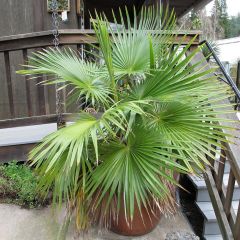
Brahea calcarea - Palm
- Flowering time August, September
- Height at maturity 12 m
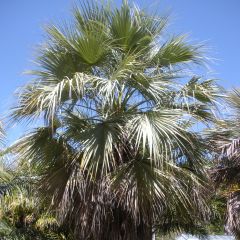
Brahea armata var. clara - Mexican blue palm
- Flowering time August, September
- Height at maturity 12 m
Brahea dulcis and Brahea brandegeei can also be found in cultivation.
Discover other Brahea
View all →Available in 1 sizes
Available in 1 sizes

Available in 2 sizes
Available in 1 sizes
Planting
Where to plant?
Brahea needs a warm and sunny location! It will appreciate excellent light conditions. Place it in a sheltered spot away from cold winds. As it originates from arid regions, Brahea thrives in rather poor, well-draining soils, whether sandy or stony. It is sensitive to stagnant moisture. However, it does not require a soil rich in organic matter. Finally, Brahea armata can withstand sea spray: it is particularly suited for coastal cultivation.
Regarding pH, Brahea prefers calcareous soils, especially Brahea calcarea, which naturally grows on the limestone hills and mountains of Mexico.
It is also possible to grow Brahea in a large container. This will allow you to bring it indoors for the winter if you live in a region with a cool climate.
Majestic palms, Brahea are stunning as solitary specimens, allowing them to be showcased perfectly. Feel free to place them near a swimming pool, for example. You can also use them to line a pathway or gate. They are also ideal as a backdrop for an exotic flowerbed.
In the cooler regions, favour Brahea armata, which can tolerate temperatures dropping to -10 to -12 °C for short periods, while in milder climates, you can choose Brahea calcarea, which is slightly more sensitive (down to -5 °C).
When to plant?
We recommend planting Brahea in spring, as soon as temperatures have warmed sufficiently and there is no longer a risk of frost.
How to plant?
For planting in the ground:
- Dig a large planting hole, two to three times the size of the root ball.
- Feel free to add draining materials (coarse sand, gravel, pumice…) to facilitate water infiltration into the soil. It is not necessary to add compost.
- Add some substrate to the planting hole: for example, a mix of coarse sand, potting soil, and garden soil.
- Gently remove the Brahea from its pot and plant it, ensuring that the stipe is upright. The base of the stipe should be level with the soil or slightly above (be careful not to bury the collar).
- Fill in by replacing substrate around the root ball.
- Water generously.
For planting in a pot:
- Choose a large pot with drainage holes at the bottom.
- Place a draining layer at the bottom, made of clay balls or gravel.
- Then add the substrate, for example, a mix of potting soil and coarse sand.
- Plant the Brahea in the pot.
- Fill in by replacing substrate around the sides, without burying the collar of the palm.
- Lightly compact, then water.
- Place the Brahea in a greenhouse or conservatory, in a well-lit spot, or directly on your terrace if there is no longer a risk of frost.
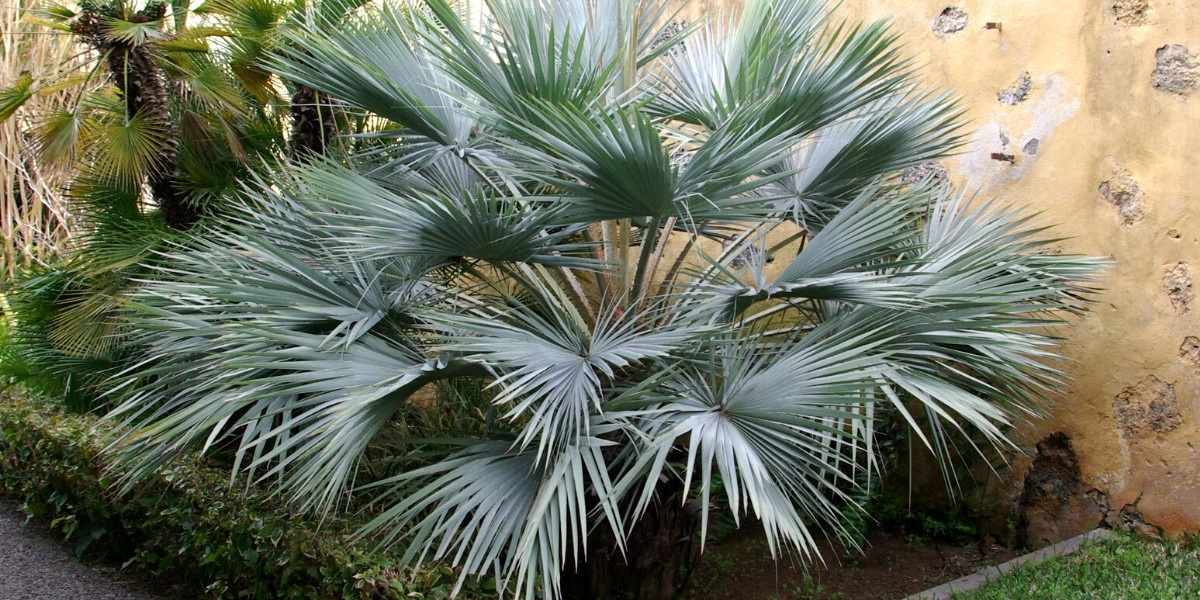
Brahea armata (photo Berthold Werner)
Entretien
For Cultivation in Open Ground
Brahea tolerates summer drought quite well; however, we recommend continuing to water regularly during the year of planting, until the palm is well established and has developed its root system. After that, water only in case of drought during the first three years of cultivation. Subsequently, it will not require watering (unless you are growing it in a pot).
In open ground, Brahea does not really need any compost or fertiliser.
The dead leaves of Brahea naturally cling to the trunk, forming a sort of skirt beneath the still green leaves. You may be tempted to cut them for aesthetic reasons, but we advise leaving them in place. These leaves, although dry, serve a purpose: they protect the palm from cold and pests by providing an insulating layer. If you do choose to trim them, do so in spring, and leave the base of the petioles, cutting a few centimetres from the trunk.
For Cultivation in Pots
If you are growing it in a pot, it will require more frequent watering than in open ground, as the substrate dries out much more quickly. Water approximately once a week from spring to autumn, and apply a little liquid fertiliser (well diluted), no more than once a month. In winter, reduce watering and stop fertiliser applications.
You can also apply a little liquid fertiliser, but it must be well diluted (more than indicated on the packaging), and no more than one application every 15 days. You may also use a slow-release fertiliser.
Remember to repot your Brahea approximately every three years in spring. Each time, choose a pot that is slightly larger than the previous one. In years when you do not repot, you can simply perform a top dressing, replacing the top few centimetres with fresh potting soil.
You can winter your Brahea in a bright and cool conservatory or greenhouse. Avoid high temperatures, such as those found indoors: a frost-free greenhouse is preferable. Brahea needs a resting period with cooler temperatures.
If you take your Brahea outside in spring and bring it back in autumn, remember to acclimatise it gradually. In general, it is best to avoid sudden changes in temperature and light. In spring, for example, start by taking it outside for a few hours each day, avoiding full sun at first until it gets used to it. After that, you can leave it in full sun all day.
Diseases and pests
Indoors, Brahea is sometimes attacked by red spider mites (Tetranychus urticae). These tiny insects, barely visible to the naked eye, pierce the leaves to consume the sap, which weakens the plant. Their presence can be detected by observing small webs woven between the leaves or petioles. As they dislike humidity, we recommend misting the foliage to get rid of them.
Brahea can also be attacked by scale insects (either mealybugs or hard scales). Like red spider mites, scale insects pierce the tissues and consume the sap of the palm. You can remove them manually when you see them, but if the infestation is more significant, it’s best to treat with an anti-scale solution. You can make your own mixture by diluting one teaspoon of black soap, one tablespoon of methylated spirits, and one tablespoon of rapeseed oil in one litre of water. Then spray this solution onto the foliage.
Outdoors, Brahea is sometimes targeted by the moth Paysandisia archon, as well as the red palm weevil, two terrible pests that cause significant damage to palms. Their presence can be noted by observing perforated fronds (in a line across the width of the fan), prematurely falling fronds, or the wilting of the crown of leaves, among other symptoms. To identify and eliminate them, we invite you to consult our dedicated sheets:
Multiplication
Sowing
It is possible to harvest seeds from Brahea and sow them. It is important to wash them thoroughly to remove the fruit pulp.
- Start by soaking the seeds in warm water for at least 48 hours. We recommend changing the water twice a day.
- Fill pots with a light, well-draining medium, such as a mix of potting soil and sand (it is best to microwave it for 10 minutes beforehand to sterilise).
- Sow the seeds.
- Cover them with 1 to 2 cm of medium, then press down lightly.
- Water gently, using a fine spray.
- Place the pots in a bright location, out of direct sunlight, at a temperature of 25 to 30 °C (it is preferable for the temperature to be slightly cooler at night than during the day).
Afterwards, continue to water regularly, but without excess, to keep the medium slightly moist.
We recommend using a mini-greenhouse to maintain a warm and humid environment, and to ventilate it occasionally to prevent mould risks.
The seeds can germinate in a few weeks, but they usually take several months (up to 8 months). The germination period is therefore quite unpredictable. Be patient if you don’t see anything sprouting!
Similarly, Brahea grows slowly: it will take several years before you see it form a true stipe.
Association
As Brahea thrives in sunny locations and well-drained soils, it is perfect for creating a dry exotic-style border. Create a garden with a mineral focus or a large rockery: build a raised bed to facilitate drainage, and place large stones to hold the soil in place. Structure the bed by planting one or more Brahea young plants at the back. In front of it, position succulents, such as Sedums and houseleeks, as well as cacti and agaves. For example, choose the impressive Agave americana, which is very graphic. Discover the Dasylirions, striking plants that bear a multitude of linear leaves in tufts, and have the advantage of being quite hardy. Also consider Delosperma and the Corsican spurge, Euphorbia myrsinites.
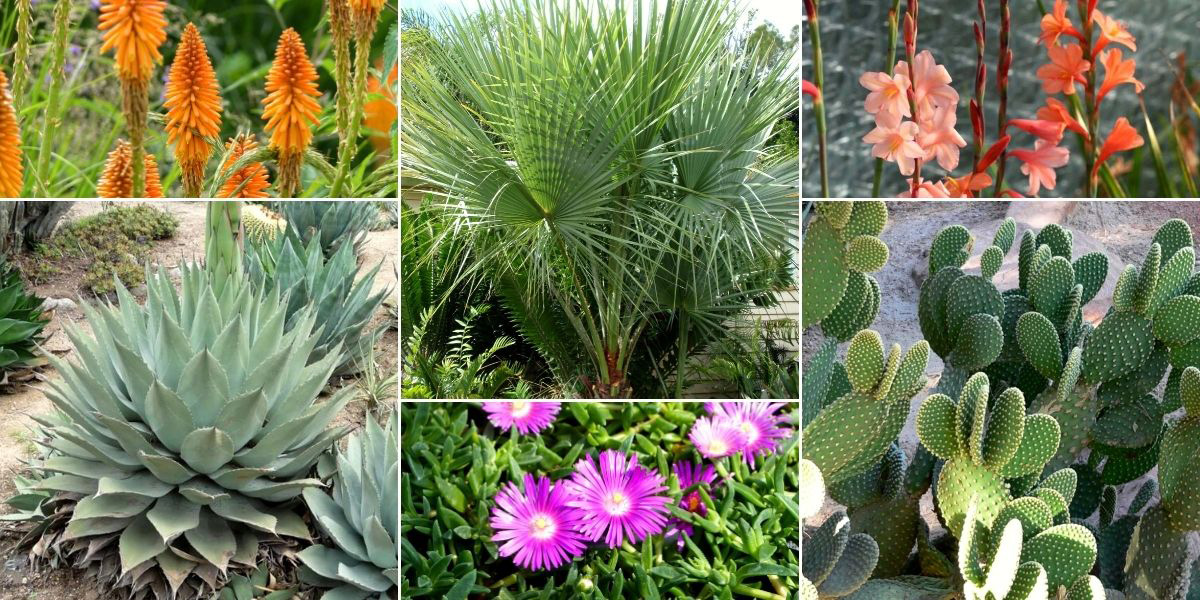
Kniphofia ‘Fiery Fred’, Brahea armata var. Clara, Watsonia ‘Peach Glow’, Agave havardiana, Delosperma cooperi and Opuntia microdasys
Brahea is ideal for coastal areas, to create a Mediterranean-inspired garden. Especially since Brahea armata tolerates sea spray very well! Place it alongside aromatic plants, such as lavender, thyme, helichrysum, wormwood, and grasses. Integrate some flowers like gaura, yarrow, echinops, and Phlomis fruticosa. For shrubs, you can pair it with olive trees, cistus, and oleanders. Also consider agaves, prickly pears, and aloes.
Finally, you can use Brahea to create a lush exotic garden, by pairing it with other palms, such as Trachycarpus fortunei, Chamaerops humilis or Washingtonia filifera. Plant alongside yuccas, cordylines, phormiums, cycads, and banana plants (for example, Musa basjoo). This will create a true oasis of greenery! To bring colour among these foliage, integrate some blooms, such as those of kniphofias, agapanthus, watsonia, callistemon, as well as the beautiful yellow flowers of Aloe striatula.
Useful resources
- Discover our range of Brahea
- For more ideas on hardy palms, feel free to check our sheet “7 hardy palms to plant almost anywhere in France”
- Also discover our general sheet with all our growing tips on palms
- The website of the Association Les Fous de Palmiers, featuring a forum
- Book Knowledge of Palms, by Pierre-Olivier Albano, published in 2002 by Edisud
- Another site with plenty of information on palm cultivation
- Our advice sheet: Palms by climate
- Subscribe!
- Contents


































Comments